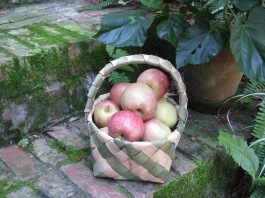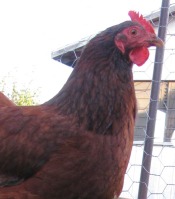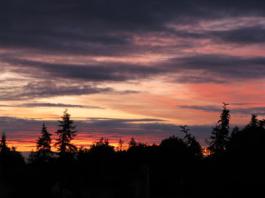Posted by David
I recently came across the curious word, Sehnsucht, while reading an article by C.S. Lewis. It forced me to look it up. It’s German and doesn’t seem to have an adequate translation in English. It’s the sort of word that’s difficult explain in any language. The closest word I know to it is nostalgia.
Wikipedia states, “Sehnsucht is a German word that literally means ‘longing’ or in a wider sense a kind of ‘intensely missing’.” I get the feeling that this word may refer to a peculiar, fleeting mood that overcomes me every now and again.
My wife was looking at a Lopi knitting book a few years back and I noticed a photograph of a house along the sea in Iceland. For a few moments I was overwhelmed with the feeling. It is like deep nostalgia, but because I’ve never been to Iceland, it’s a nostalgia for something I’ve never known. I get the same feeling for the ‘North’ country, whatever that means. High latitude skies, cold winds across the bracken might trigger the feeling in me. I also get this feeling from simpler things, especially good children’s literature. Try the original Winnie-the-Pooh Series, especially the last chapter of The House at Pooh Corner.
I also get the feeling when think about The Hobbit and Tolkien’s Lord of the Rings series. After reading those books in rapid succession, I went through a mild depression when I realized I had left the place for good, the series of books were over and I couldn’t go back. Today, I still long for the Shire in my life. But it can’t be. I know that. There is a purpose of Sehnsucht and its purpose is to point us in the direction of life. We are not supposed to go back or retreat into or relive or even seek out to restore the Sehnsucht in our lives. I expect that one day I will awaken into it. I will learn that it was God calling all along. If I understand correctly, this is how C.S. Lewis understood it, too.
Just a couple of days ago I had another experience with Sehnsucht in the early morning hours. I had one of what I call my ‘Nostalgia Dreams’. It’s always the same. I’m in a beautiful dream, usually of childhood. Then I slowly recognize in the midst of the dream that it’s only a dream. Then it hits me. An intense wave of sadness, akin to depression, sweeps over my body. The feeling is so strong that I’m shocked into consciousness. At first, I can still feel the deep longing and sadness. Within about a minute or so, it is mostly faded. But the feeling never really ever fades completely. My entire being lives partially in Sehnsucht. Today, I know it’s God calling me home.
It makes me wonder if Jesus lived his life on earth with this feeling. As Emanuel, ‘God with us’, how greatly he must have longed to return to his Father.
The light ahead was growing stronger. Lucy saw that a great series of many-colored cliffs led up in front of them like a giant’s staircase. And then she forgot everything else, because Aslan himself was coming, leaping down from cliff to cliff like a living cataract of power and beauty…
Then Aslan turned to them and said: “You do not yet look so happy as I mean you to be.”
Lucy said, “We’re so afraid of being sent away, Aslan. And you have sent us back into our own world so often.”
“No fear of that,” said Aslan. “Have you not guessed?”
Their hearts leaped and a wild hope rose within them.
“There was a real railway accident,” said Aslan softly. “Your father and mother and all of you are—as you used to call it in the Shadowlands—dead. The term is over: the holidays have begun. The dream is ended: this is the morning.”
And as He spoke He no longer looked to them like a lion; but the things that began to happen after that were so great and beautiful that I cannot write them. And for us this is the end of all the stories, and we can most truly say that they all lived happily ever after. But for them it was only the beginning of the real story. All their life in this world and all their adventures in Narnia had only been the cover and the title page: now at last they were beginning Chapter One of the Great Story which no one on earth has read: which goes on forever: in which every chapter is better than the one before.
The Last Battle, The Cronicles of Narnia, C.S. Lewis

 Driving is clearly a skill that requires a lot of practice to perform well, but something that most anyone can do reasonably adequately without getting into trouble. I guess here we’re talking about a normative skill, something that doesn’t require the exactitude of science, but that also doesn’t demand the unique expressiveness of art.
Driving is clearly a skill that requires a lot of practice to perform well, but something that most anyone can do reasonably adequately without getting into trouble. I guess here we’re talking about a normative skill, something that doesn’t require the exactitude of science, but that also doesn’t demand the unique expressiveness of art. If the craftsperson is himself/herself the designer and if the design is individualized and unique in some way and reflects beauty in the eye of the beholder, it seems to me that we can call the product art. If the product is mass produced, we don’t have craft production, but may very likely have art in the design. And let us not neglect to say that the ability to provide multiple copies of great art enables it to be shared by many who would otherwise not be so graced. A purist might say that a copy never possesses that certain “je ne sais quoi” of the artist.
If the craftsperson is himself/herself the designer and if the design is individualized and unique in some way and reflects beauty in the eye of the beholder, it seems to me that we can call the product art. If the product is mass produced, we don’t have craft production, but may very likely have art in the design. And let us not neglect to say that the ability to provide multiple copies of great art enables it to be shared by many who would otherwise not be so graced. A purist might say that a copy never possesses that certain “je ne sais quoi” of the artist. Also, we know that there were people we would now call architects or engineers that designed the structure, and clearly the friezes were designed by artists, though no one would deny that art was involved in the overall design of the structure. Were the craftsmen who carved the friezes artists in their own right? Obviously we don’t know; but we can conclude that the people who did the stonework were all highly skilled, working from detailed designs, and likely not able to individualize their products using their own imagination or creativity, as was seen in some of the religious sculpture adorning cathedrals in the middle ages.
Also, we know that there were people we would now call architects or engineers that designed the structure, and clearly the friezes were designed by artists, though no one would deny that art was involved in the overall design of the structure. Were the craftsmen who carved the friezes artists in their own right? Obviously we don’t know; but we can conclude that the people who did the stonework were all highly skilled, working from detailed designs, and likely not able to individualize their products using their own imagination or creativity, as was seen in some of the religious sculpture adorning cathedrals in the middle ages. It’s clearly a craft with artistic aspects, and to do it well requires great skill. I became intimidated on the first page, and must confess that I remain, after working at bread making desultorily for several years, a rank beginner. That’s part of the problem, of course – I mean the desultoriness. I think I’m beginning to see (and I’m not learning this just from bread making) that to really become good at anything, what is required most of all is practice, practice, practice – so much so that at some point, one begins to function on automatic. What that means is that the neurological and muscular responses are so well learned that they are managed at a subconscious level. I suspect that though we are unaware of it, virtually all of our well learned activities are controlled and directed at a subconscious level. Our awareness is literally the very tip of the iceberg of mental processing.
It’s clearly a craft with artistic aspects, and to do it well requires great skill. I became intimidated on the first page, and must confess that I remain, after working at bread making desultorily for several years, a rank beginner. That’s part of the problem, of course – I mean the desultoriness. I think I’m beginning to see (and I’m not learning this just from bread making) that to really become good at anything, what is required most of all is practice, practice, practice – so much so that at some point, one begins to function on automatic. What that means is that the neurological and muscular responses are so well learned that they are managed at a subconscious level. I suspect that though we are unaware of it, virtually all of our well learned activities are controlled and directed at a subconscious level. Our awareness is literally the very tip of the iceberg of mental processing.





